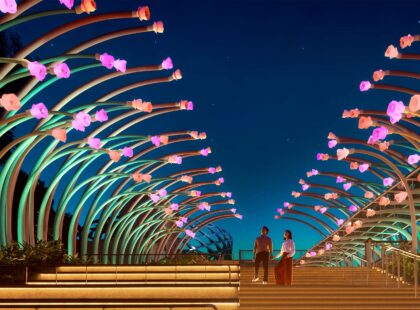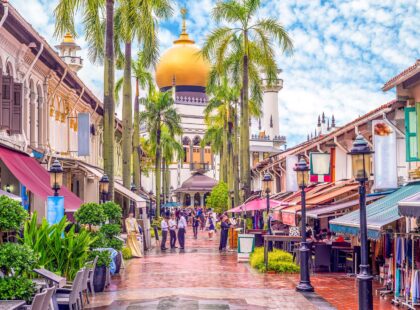Salamah Klathale pulls deeply on the oar, water droplets glistening on the long blade before he plunges it back into the clear blue water of the bay. His lined features and ragged grey beard hint at his advanced age, but sitting on the prow of the kabang, a traditional houseboat made of wood, bamboo and pandanus leaves, it’s easy to imagine him in his younger days, traversing the Andaman Sea without a thought for the restrictions of national borders.

In his 60s, Salamah is a member of the Moken community, which lives on the idyllic jungle-fringed beach of Ao Bon Yai. The beach is situated on the tropical island of Koh Surin, a national park since 1981, located 60km from the Phang Nga mainland and a few hours north of Phuket.

Also known by the less-appreciated moniker of sea gypsies, the formerly nomadic Moken used to spend their lives at sea, travelling between the islands of Myanmar and Thailand and surviving off what they could harvest from the ocean and the land. “It was up to the boat where we went,” remembers Salamah of his former wandering lifestyle. “We’d just untie it and then feel where it wanted to go.”
That life is fast becoming a distant memory for the Moken, who due to tighter government controls have been forced to adopt a more sedentary existence over the past 30 years. The threats of border patrols and unscrupulous fishing operations mean that these once-stateless people now fear the open water they used to call home. Instead they find themselves forced to eke out an existence within the constraints of modern society, bound by the rules of the national park they now live within.
But right now, with the waves gently lapping against the wooden hull of the kabang and the curved thatched roof providing protection against the rays of the morning sun, these worries are momentarily forgotten. In between strokes, Salamah still has the energy to joke that he’s going to row us all to Myanmar, where many Moken still live among the islands of the Mergui Archipelago. The rest of the crew, on board to celebrate the maiden voyage of the newly repaired kabang, collapse in giggles.

Tourism now holds major sway over the Moken people. Located in a national park that’s a big draw for snorkelling tours thanks to its empty beaches, clear waters and abundant coral, their village has inadvertently become something of a sideshow for visitors. During the dry season between May and October, a fleet of growling speedboats heralds the daily mini-invasion of bathing suit-clad sightseers, who then proceed to wander uninvited through the heart of the village. It’s a dispiriting sight.
Depressing as it may be, these tourists are also the main source of income for most of the Moken, who have started selling handmade bracelets and wood carvings. The only alternative employment is menial jobs on the speedboats for the men, or work as cleaners and cooks at the park headquarters for the women. In both cases, this is tough work and limited to the dry season, when the park is open.

“We’re happy to see them buy our handicrafts and help us make a living,” says the village chief, the soft-spoken 30-something Ngoey Klathale (all the Moken share the same last name), of the tourist intrusion. “But we’re also happy to see them leave so we can pack up and get on with our day.”
Indeed, it’s noticeable how the mood changes once the tour boats have roared off to the many snorkelling spots around the archipelago. A sense of contented calm descends as the makeshift stalls are quickly packed away from the sandy main street that bisects the rows of stilted huts.
The children, released from their roles as salespeople, scamper off to splash in the shallows, chase old tyres down the beach or play with shells in the sand. Groups of women, many with babes in their arms, loosen their sarongs and congregate in the welcome shade afforded by their huts.
The men, too, visibly relax and head back to their work repairing their long-tail boats, while happily passing around supplies of coffee and tobacco. There are no doors on the 80-odd huts that occupy this remote stretch of sand, and the sense of a tight-knit community at peace with itself is palpable.
Origins of a people
While it seems that the Moken have been around for hundreds of years, their origins remain unclear. According to legend, there were two sisters called Moo and Gan. One day, Moo’s husband accidentally entered Gan’s room. Thinking her husband was being unfaithful, the distraught Moo (whose name means “sink” in Moken) took to the ocean. Gan and the rest of the village went out in boats to find her, and continue their search till this day.
Village people
For centuries, the Moken community used to spend the majority of their lives travelling together in family groups between the bays and islands of the Andaman Sea. These days, over 300 Surin and Burmese Moken live as a tight-knit community in an 80-hut village on Ao Bon Yai, on the Thai island of Koh Surin.
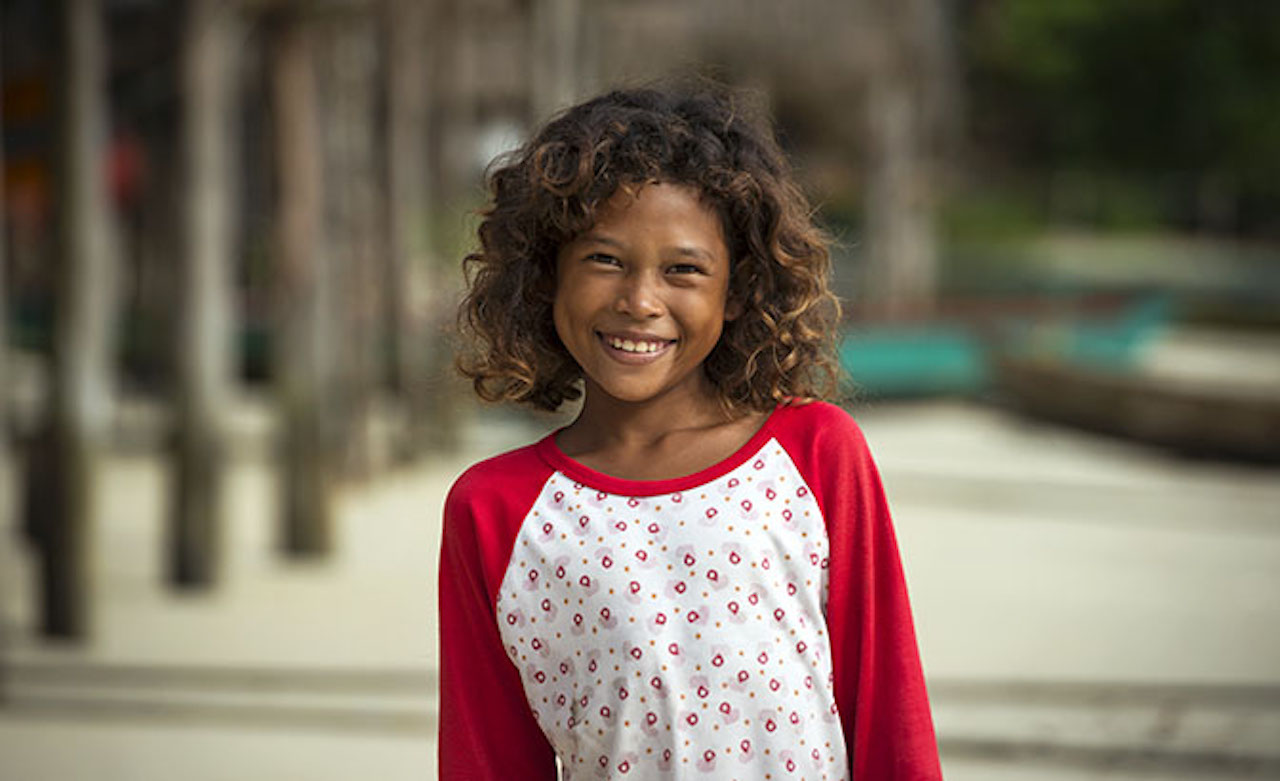
We’re allowed an extended glimpse into the daily life of the community thanks to a wise-cracking Moken named YaYo, one of the five guides currently working for the Moken Tourism Team.

“There are fewer of the older generation left,” admits YaYo with a wry smile, when explaining why he decided to join the Team. “I feel that the group is a way of sparking interest in the younger generation, showing them that they can be proud of their culture.”
The Moken Tourism Team is a project that’s been over a decade in the making. It was first initiated as the Andaman Pilot Project a year after the 2004 tsunami.
In 2010, community-based tour operator Andaman Discoveries began working with the group to train guides. Since 2012, they have been running a series of specialist tours that allow visitors to spend a few days in the village to learn more about Moken customs.

Traditionally very shy, it’s clear that opening up to the outside world and embracing tourism still isn’t a very comfortable experience for the Moken. Fortunately, shyness is not an affliction that Salamah suffers from. He enthusiastically ushers us towards his small home, built for him by the community after his wife and family died. He wants to show us some traditional goggles he has made, using hardwood from the jungle and pieces of glass from the beach.
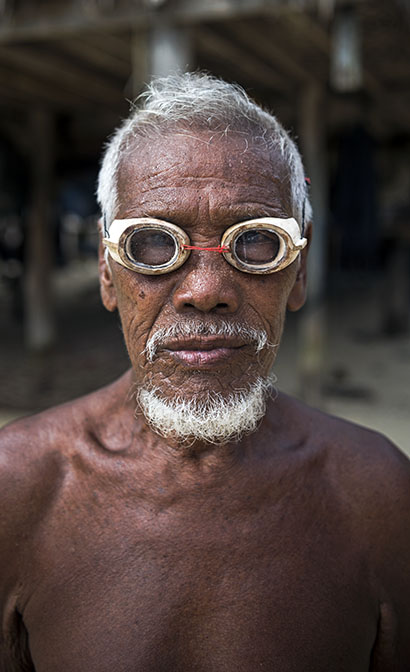
The affection and respect the Moken feel towards their village elder is clear. The former headman, Salamah was one of the people who noticed the unusual behaviour of the sea on Boxing Day in 2004 and ordered the whole village to higher ground before the devastating tsunami hit. As a result, no Moken lost their lives. Even today, he continues his role as one of the four traditional healers in the village, using natural herbs and plants and calling on the surrounding spirits of the jungle to soothe away any aches and pains. He is also one of the few remaining Surin Moken who still know how to construct the kabang.
The kabang is at the heart of the Moken’s former life, seen as part of the family; as a result, maintaining the village kabang is a key part of the project’s aims.
“The kabang is central to our culture,” explains Ngoey, who also acts as a guide, as we sit drinking instant coffee on the veranda of his house. “It’s one of the main reasons we set up the group, to show the younger generation how we used to live.”
Ceremonial ties
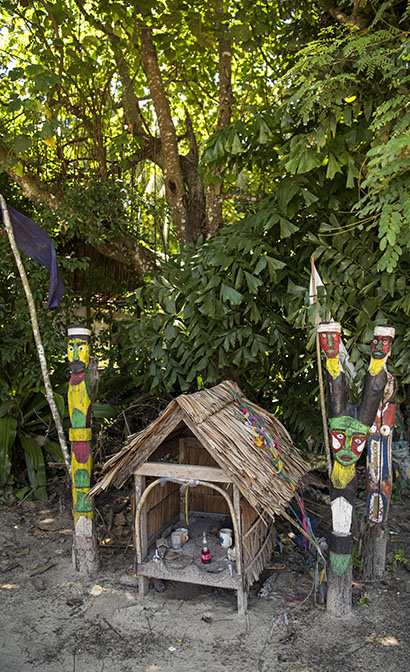
Each Moken village features a small shrine anked by spirit poles. This is the focal point for the La Bong, the Moken’s largest annual ceremony. Featuring three days of drinking, dancing and feasting, it’s held during the 15th cycle of the moon (normally in May). A new spirit pole is carved and offerings of food are placed on small houseboats and launched into the sea for the ocean spirits. A highlight of the calendar, it’s an excuse for the wider community to get together, with Moken from Myanmar and the Thai mainland travelling to Surin to join in the festivities.
Snorkelling trips reveal the rich marine life in the island’s waters, as well as YaYo’s uncanny ability to spot even the smallest of sea creatures. Studies have shown that the Moken are able to see further beneath the waves, their eyes adjusted to the underwater world from a young age. Spearfishing and outings on a sa pan (small rowboat), used by the women to harvest the shellfish that cover the rocks around the bay, further demonstrate the community’s affinity with the sea.
And it’s not just on the water that the Moken thrive. As we trek through the surrounding jungle that hems in the village. YaYo explains how the Moken use many of the plants and trees for food and as construction materials for their boats and houses.
A morning spent hand-weaving bracelets and containers using pandanus leaves underlines the Moken’s ability to utilise their surroundings. This activity, which was only added to the tour programme in 2016, shows the increasing willingness of the Moken women to get involved in what was previously a male-dominated project.
Sabai is one of the women embracing the aims and ambitions of the programme. The 60-something mother of 11 is one of the last Moken in the village who spent the majority of her life on a kabang. Since a visit to a traditional healer in Myanmar left her blind, she rarely moves from her home, but still yearns for life out on the boats.
“We had the freedom to go where we wanted,” she recalls. “I wish my children could have the life I had.” It’s a sentiment echoed among many of the Moken – a deep yearning for their former nomadic life.

That sense of longing rings clearest in the traditional songs that Sabai still performs at Moken funerals and at the annual Lobong ceremony, accompanied by her husband Tat on a simple wooden hand drum called a ba nang. In fact, she is the last person in the community who can still sing these plaintive ballads.

And sadly, the tradition is set to pass away with her. “None of the children know how to sing,” she explains. “It was the sound I grew up listening to. It’s ingrained in me. Now the music is so different, the kids just don’t know how.” Listening to her sing about life on the ocean and the strong familial bonds between the Moken, it’s hard not to be deeply moved.
And it’s these interactions with the Moken themselves that make the tour so unique. Rightly proud of their customs and traditions, they are fighting hard to pass them on to the next generation. Through the work of the Moken Tourism Team, they are beginning to see that there are ways that they can interact with the outside world, but do so on their own terms. It’s a way forward that offers a chance to keep the community together, despite the pressures and hardships they face. After all, as YaYo points out, “the Moken are happiest when we’re together.”
SEE ALSO: Meet Bali’s ninth generation kris maker
This article was originally published in the December 2017 issue of Silkwinds magazine


